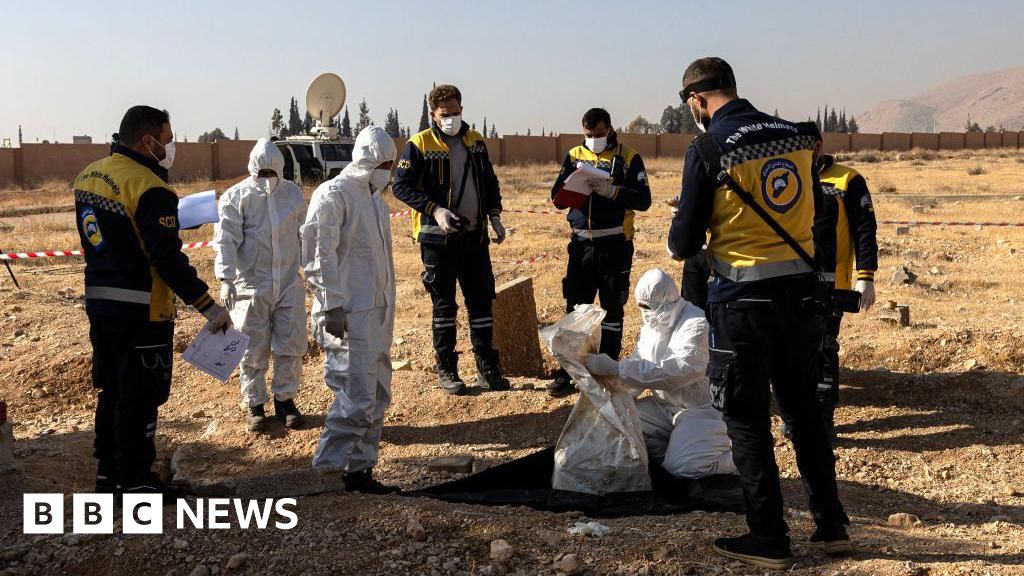 Getty Images
Getty ImagesLess than 10 kilometers (six miles) from the bustling center of Damascus, in the northwestern suburb of Adra, a dry patch of land is isolated by cement walls.
As you enter, a team of rescuers from the humanitarian organization White Helmets can be seen on the left side searching for mass graves.
Over the past few days, videos have been posted online of mass graves where the Bashar al-Assad regime has been burying those tortured to death in Syria’s notorious prisons.
In Adra, the White Helmets had discovered a small hole where several large white plastic bags were filled with the remains of bodies.
One message read simply: “Seven bodies, eighth grave, unknown.”
The team was removing the remains, skulls and bones they collected. DNA samples were placed separately in black body bags for documentation and further analysis.
Ismael Abdullah, one of the rescuers, says they carry a heavy burden on their shoulders.
“Thousands of people are missing. It will take time – a lot – to get to the truth of what happened to them,” he says.
“Today, after receiving a call about a possible mass grave here, we found the remains of seven civilians on the ground.
He adds that all the necessary procedures have been carried out “so that in the future we can identify those people who were killed”. The team is among the few trained to document and collect forensic evidence.
 BBC/Dokson Institute
BBC/Dokson InstituteMore than 100,000 people are believed to have disappeared in Syria since 2011.
In the past week, the Hayat Tahrir al-Sham (HTS) rebel group – which toppled Assad after more than 50 years of rule by his family – opened prisons and detention centers across Syria.
Human rights groups have concluded that more than 80,000 of the disappeared are dead. Another 60,000 people are believed to have been tortured to death, according to the UK-based war monitor the Syrian Observatory for Human Rights (SOHR).
Locals are reporting more and more mass graves in Syria, and the Syrian Emergency Task Force (SETF), a US-based NGO, says nearly 100,000 bodies have been found so far.
Human Rights Watch says such graves should be protected and explored.
Elsewhere in the city of Qutayfa, further northwest of Damascus, the SETF says thousands of bodies are believed to be buried in various mass graves.
A local resident who witnessed the burial of bodies during the years of Syria’s civil war said they were packed in refrigerated containers brought in by security forces.
The ground will be full of bodies – and then the site will be bulldozed, he told the BBC.
 BBC/Dokson Institute
BBC/Dokson InstituteQutayfah religious leader Abdul Qadir al-Sheikha witnessed one such mass burial.
The secret police asked him to come and arrange the funeral, he said. He tried to perform the religious rites for the dead and prayed for them.
He tells me that in these 30 sq. m, at least 100 people are buried. The police were never called after that, he adds.
“They called them terrorists who didn’t deserve a burial. They didn’t want anyone to witness what they were doing,” says Mr Sheikha.
The secret police do not allow people to walk past the mass grave sites or even look out their windows when they carry out the burial, another witness who was forced to participate told me.
There are many such mass graves in the suburbs of Damascus, the witness said.
Elsewhere in Husseiniyeh, on the road that leads to Damascus airport, satellite images show differences in the landscape of areas where mass graves have been found.
 BBC/Dokson Institute
BBC/Dokson InstituteAs the Assad regime crumbled in the face of a rapid rebel advance, thousands of Syrian families rushed to prisons and detention centers to search for their missing loved ones.
They need closure and honoring the dead with a proper burial.
In one detention center, hundreds of identity documents of Syrians detained by Assad’s security forces were scattered on the ground.
A woman was still searching for her missing brother, who went missing in 2014. A father was searching for his son, who was detained in 2013. No one is ready to give up the search.
But locating and protecting the mass graves and identifying the bodies they contain are tasks that few Syrians are currently able to carry out – and international experts are urgently needed to help in the process.

https://ichef.bbci.co.uk/news/1024/branded_news/07c6/live/79a09ed0-bca5-11ef-b63a-f359206dd36b.jpg
2024-12-17 21:36:25


